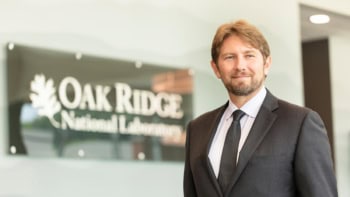
Have you ever wished you could go back in time and change your decisions? If only knowledge from today could travel back in time with us, we could alter our actions to our advantage. For now, such time travel is the stuff of fiction, but a trio of researchers have shown that by manipulating quantum entanglement, one can, at least, design experiments that simulate it.
Writing in Physical Review Letters, David Arvidsson-Shukur of the Hitachi Cambridge Laboratory, UK; Aidan McConnell of the University of Cambridge, UK; and Nicole Yunger Halpern of the US National Institute of Standards and Technology (NIST) and the University of Maryland propose a set-up in which an experimentalist sends information back in time to retroactively – in effect – change their actions in a way that produces optimal measurements. Intriguingly, the trio reveal that such simulated time travel in entangled systems can facilitate physical advantages that would be impossible to achieve in purely classical systems.
The science of quantum measurements
While actual backward time travel is hypothetical, quantum mechanical versions have been proposed and simulated experimentally. A crucial ingredient of these simulations is teleportation, wherein a state from the experiment’s intermediate step is effectively sent back to the beginning. For this to be possible, the states must be entangled. In other words, they must share a type of quantum connectedness that arises between two (or more) particles such that the state of one cannot be defined independently of the other(s).
Since these simulations of time travel rely on quantum mechanics, they enable researchers to ask meaningful questions about the nature and advantages, if any, of quantum systems. In the new work, Arvidsson-Shukur, McConnell and Yunger Halpern do just that by investigating what advantages simulations of backward time travel can have for quantum metrology – a field of physics that uses quantum mechanics to make highly precise measurements.
A typical quantum metrology problem deals with estimating some unknown parameter of a system or process using quantum mechanical probes. Once the probes are prepared and made to interact with the system, the way the probes’ state transforms will encode information about the unknown parameter. The goal is to learn as much information as possible per probe.
Post-selective measurement can assist in this. In this process, the experimentalist makes a measurement and then, depending on the outcome, chooses to include or exclude certain experimental results from analysis. This concentrates the information learned per probe.
Previously, Arvidsson-Shukur, Yunger Halpern and their collaborators demonstrated that in a quantum system, choosing an optimal input probe state can enable an experimentalist to gain more information per probe than is possible classically. However, typically the experimentalist learns which input state would have been optimal only after the interaction occurs. In a scenario without time travel, this is no good.
Advantage of simulated time travel
If, however, the experimentalist teleports the optimal input state back in time via entanglement manipulation, the trio show that this could produce novel operational advantages. In their proposal, an experimentalist prepares a pair of maximally entangled quantum bits, or qubits, called A and C, plus an additional qubit as the probe. The goal is to measure the strength of an unknown interaction using the probe. Initially, the experimentalist is unaware of the optimal input state for A. At the first step, the probe and qubit A interact. The information about the unknown parameter of the interaction is encoded in the probe’s state. At an intermediate step, however, the experimentalist measures the state of qubit A. This measurement reveals information about the as-yet-unknown optimal state.
Next, the experimentalist uses this information to prepare an auxiliary qubit D in this optimal state. Then, they measure the joint state of the qubits C and D. If this joint state does not match the initial joint state of A and C, the measurement is discarded from the analysis. This effectively picks out instances where optimally prepared state D teleports into the original state of qubit A. The teleportation implies that when the experimentalist measures the probe, they record optimal information gain even though they did not, initially, prepare the probe in the optimal state.

A steampunk guide to quantum physics
During the experiment, the experimentalist would discard many non-matching measurements. That might seem costly. However, the measurements the experimentalist keeps – the ones where the teleportation is successful – have high information gain per probe. Overall, the information gained from a few optimal probes outweighs the losses when summed over multiple trials.
Whether time travel is physically possible or not is still debated. However, experimentalists can use quantum mechanics and simulate time travel in the lab to perform more precise measurements. As Arvidsson-Shukur, McConnell and Yunger Halpern conclude in their paper, “While [time-travel] simulations do not allow you to go back and alter your past, they do allow you to create a better tomorrow by fixing yesterday’s problems today.”



